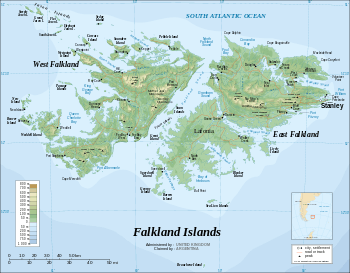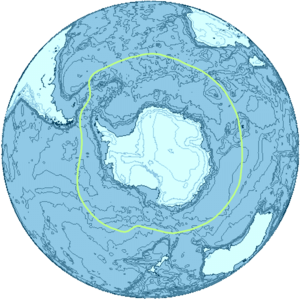Climate of the Falkland Islands

The climate of the Falkland Islands is cool and temperate, regulated by the large oceans which surround it. The Falkland Islands are located over 480 kilometres (298 mi) from South America, to the north of the Antarctic convergence, where cooler waters from the south mix with warmer waters from the north.
Winds mostly come from the west, creating a difference between the relative levels of precipitation between the eastern islands and the western islands. The total annual rainfall is only about 573.6 mm (23 in). Although snow falls, it does not settle due to the strength of the winds.
The temperature of the islands fluctuates within a narrow band, not reaching higher than 24 °C (75 °F) or lower than −5 °C (23 °F). There are long hours of daylight in the summer, although the actual number of hours of sunlight is limited by cloud cover.
Köppen classification
The Falkland Islands have a maritime climate in the transition region between the temperate and subarctic zones (Köppen classifications Cfb and Cfc respectively).[1] The climate is very much influenced by the cool South Atlantic ocean and its northerly Patagonian current. The oceanic climatic type is characterised by both low seasonal and diurnal temperature ranges and no marked wet and dry season while in the sub-arctic zone the average monthly maximum temperature exceeds 10 °C (50 °F) for no more than four months of the year and the average monthly minimum does not drop below −3 °C (27 °F).
In addition to parts of the Falklands, a maritime subarctic climatic zone is found in parts of coastal Iceland, Faroe Islands, northwestern coastal Norway, southern islands of Alaska and parts of the Alaskan Panhandle, the southern tip of South America and mountainous areas of Europe including the Scottish Highlands and southwestern Norway.[2]
Sunshine
During summer the Falklands experience long daylight hours.[3] During summer the islands run on Daylight Saving Time, at UTC -3 as opposed to the normal time of UTC -4, entering summer time at 2 am on the first Sunday of September and leaving it on 2 am on the third Sunday of April.[4] However, due to cloud cover, the average number of hours in summer with direct sunlight is only 6 hours. The average number in winter is only 2–3.[5] In 2011, the Falkland Islands government announced that the islands will remain on summer time during the winter, when the clocks would normally be set back.[6]
Winds
The winds moving over the islands are mostly westerly winds.[7] There is almost no seasonal variation in wind direction, which is less than 17 knots for 60 percent of the time, from 22 to 33 knots for 20–25 percent of the time, and 34 and above 8–12 percent of the time.[8] Gales are frequent, especially during winter.[5] Average wind speed in Stanley is 16 knots.[8]
Temperature

The islands have a cool temperate temperature,[7] which fluctuates in a narrow range.[4] Average monthly temperatures range from around 9 °C (48 °F) in January and February to around 2 °C (36 °F) in June and July, corresponding with summer and winter.[7] The maximum temperature reached is around 24 °C (75 °F) in January, and the minimum is −5 °C (23 °F) in July. The annual average is around 5.6 °C (42 °F).[4]
The archipelago is located 300 miles (483 km) from the coast of South America, between 51° and 52°S. The location of the archipelago, to the north of the Antarctic convergence, helps to moderate the temperature as cool waters from Antarctica mix with warmer waters from the Atlantic.[7]
Precipitation
Rainfall remains almost constant throughout the year,[4] although it is low because of the archipelago's location to the east of South America.[8] Owing to the westerlies and the shielding effect of the Andes,[9] the western side of the archipelago is much drier than the eastern side, and mountain ranges are much wetter on their eastern slopes than their western slopes. Port Stanley and Port Howard on eastern islands both receive about 630 mm (25 in) of rainfall every year, as opposed to islands such as Westpoint which only receives 430 mm (17 in) a year.[7] The overall rainfall for the archipelago is around 573.6 mm (23 in).[3] The flat areas, in particular Lafonia are the driest areas of the islands with precipitation in the range 273–485 mm (11–19 in) a year.[10] Other writers have recorded an average of 310 mm per year in the west of the islands.[11]
The rainfall in 2009 as recorded from 17 different stations in The Wool Press varied between 356 mm at Cape Dolphin and 898 mm at Port Howard.[12]
During winter sleet and snow does fall, but it is temporary and does not settle for long.[5] Although the climate is semi-arid, the ground remains damp as it is often impermeable to water.[8]
Effects of climate change
The climate has become drier and warmer over the past 50 years, but it is predicted that the islands will become cooler with more rain and cloud cover. This is because melting Antarctic ice is predicted to result in cooler air from the south, counteracting warmer air from the north. Sea temperature has also risen steadily since the 1960s. Rainfall data suggests that it increased from 1910 to 1940, decreased until 1995, then began to increase again. Storms are predicted to increase in frequency and intensity.[8]
This information has been determined through meteorological data from 1923 to 1981, with most recent data not being fully analysed. The temperature of the sea around the archipelago fluctuates greatly around predicted values.[8]
Climate stats
| Climate data for Stanley, Falkland Islands, 2m asl, 1929-1970 (Sunshine 1931-1960) | |||||||||||||
|---|---|---|---|---|---|---|---|---|---|---|---|---|---|
| Month | Jan | Feb | Mar | Apr | May | Jun | Jul | Aug | Sep | Oct | Nov | Dec | Year |
| Record high °C (°F) | 24.4 (75.9) |
23.3 (73.9) |
21.1 (70) |
17.2 (63) |
14.1 (57.4) |
10.6 (51.1) |
10.0 (50) |
11.1 (52) |
15.0 (59) |
17.8 (64) |
21.7 (71.1) |
21.7 (71.1) |
24.4 (75.9) |
| Average high °C (°F) | 13.3 (55.9) |
12.8 (55) |
11.7 (53.1) |
9.4 (48.9) |
6.7 (44.1) |
5.0 (41) |
4.4 (39.9) |
5.0 (41) |
7.2 (45) |
8.9 (48) |
11.1 (52) |
12.2 (54) |
9.0 (48.2) |
| Average low °C (°F) | 5.6 (42.1) |
5.0 (41) |
4.4 (39.9) |
2.8 (37) |
1.1 (34) |
0.0 (32) |
−0.6 (30.9) |
−0.6 (30.9) |
0.6 (33.1) |
1.7 (35.1) |
2.8 (37) |
3.9 (39) |
2.2 (36) |
| Record low °C (°F) | −1.1 (30) |
−1.1 (30) |
−2.8 (27) |
−6.1 (21) |
−6.7 (19.9) |
−11.1 (12) |
−8.9 (16) |
−11.1 (12) |
−10.6 (12.9) |
−5.6 (21.9) |
−3.3 (26.1) |
−1.7 (28.9) |
−11.1 (12) |
| Average precipitation mm (inches) | 71.0 (2.795) |
58.0 (2.283) |
64.0 (2.52) |
66.0 (2.598) |
66.0 (2.598) |
53.0 (2.087) |
51.0 (2.008) |
51.0 (2.008) |
38.0 (1.496) |
41.0 (1.614) |
51.0 (2.008) |
71.0 (2.795) |
681.0 (26.811) |
| Mean monthly sunshine hours | 198 | 161 | 169 | 115 | 77 | 57 | 69 | 90 | 128 | 189 | 200 | 198 | 1,651 |
| Source #1: Globalbioclimatics/S.Rivas-Martínez [13] | |||||||||||||
| Source #2: DMI/Danish Meteorology Institute - page 87 [14] | |||||||||||||
References
- ↑ "Climate Zones: South America" (PDF). New York: Socioeconomic Data and Applications (SEDAC), Earth Institute, Columbia University. 2012. Retrieved 8 June 2012.
- ↑ "Common Expressions: Oceanic Climate". Webster's Online Dictionary. Retrieved 6 June 2012.
- 1 2 "The Falkland Islands" (PDF). Falkland Islands Tourist Board. Archived from the original (PDF) on 10 July 2011. Retrieved 6 April 2011.
- 1 2 3 4 "The Islands:Location". Falkland Islands Government. 2007. Retrieved 6 April 2011.
- 1 2 3 "Falkland Islands". BBC. 2007. Retrieved 25 March 2011.
- ↑ "Falkland Islands will remain on summer time throughout 2011". MercoPress. 31 March 2011. Retrieved 8 April 2011.
- 1 2 3 4 5 Mike Bingham. "Falklands/Falkland Islands". International Penguin Conservation Work Group. Retrieved 2011-03-24.
- 1 2 3 4 5 6 Otley H, Munro G, Clausen A, Ingham B (May 2008). "Falkland Islands State of the Environment Report 2008" (PDF). gov.fk. Retrieved 25 March 2011.
- ↑ Turner, John; Pendlebury, Steve (5 November 2008). "Representative sub–Antarctic Islands: The Falkland Islands". The International Antarctic Weather Forecasting Handbook. British Antarctic Survey. Retrieved 12 June 2012.
- ↑ McAdam, Jim (15 March 2012). "Climate Change in the Falkland Islands - A Project by the United Kingdom Falkland Islands Trust." (PDF). United Kingdom Falkland Islands Trust. Retrieved 14 June 2012.
- ↑ White, R W; Gillon, K W; Black, A D; Reid, J B (2002). "The distribution of seabirds and marine mammals in Falkland Islands waters" (PDF). Peterborough, United Kingdom: Joint Nature COnservation Committee. p. 11. ISBN 1 86107 534 0. Retrieved 5 October 2012.
- ↑ "Weather Summary & Rainfall Totals" (PDF). The Wool Press. Department of Agriculture, Falkland Islands Government. 240: 14. January 2010. Retrieved 26 November 2012.
- ↑ "Temp/Rain 1929-70". Globalbioclimatics. Apr 2012. Retrieved 24 April 2012.
- ↑ "Sunshine 1931-1960" (PDF). DMI.DK. Apr 2012. Archived from the original (PDF) on 27 April 2013. Retrieved 24 April 2012.